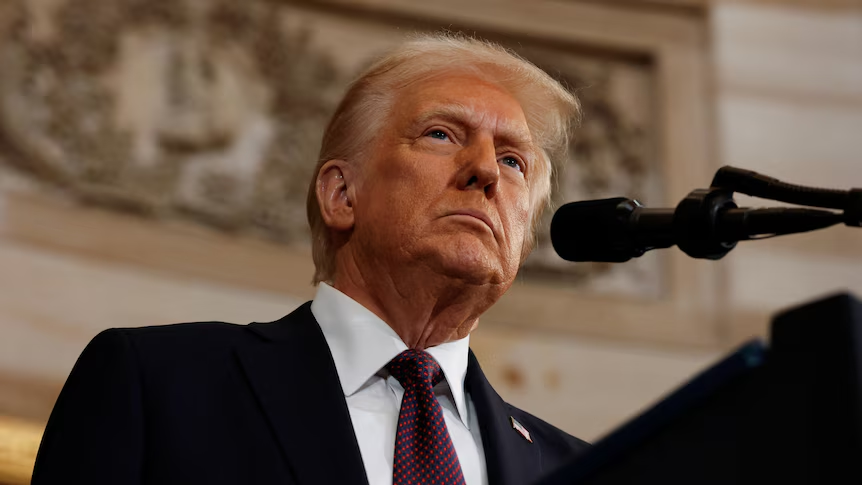US President Donald Trump has issued a strong warning nations aligning themselves with BRICS in ways that contradict American interests could soon face an added 10% tariff.
“Any country aligning themselves with the Anti-American policies of BRICS, will be charged an ADDITIONAL 10% tariff. There will be no exceptions to this policy,” Trump wrote on social media.
Trump has maintained a longstanding opposition to BRICS, a geopolitical bloc that includes major players such as China, Russia, and India.
While the US had initially provided a deadline of July 9 for countries to finalize trade deals, officials now say duties will be enforced starting August 1. Trump stated he would notify countries in writing of the new rates should no agreements be reached before the deadline.
Treasury Secretary Scott Bessent, speaking on Monday, suggested that the final days before the cut-off would be packed with negotiations.
“We’ve had a lot of people change their tune in terms of negotiations. So my mailbox was full last night with a lot of new offers, a lot of new proposals,” he said.
To date, the US has completed formal trade deals with the United Kingdom and Vietnam, and reached a partial agreement with China.
Still, ongoing talks between the US and the UK have yet to resolve disputes over American tariffs on British steel.
Since returning to the presidency in 2025, Trump has introduced multiple waves of import duties, arguing these measures will revitalize domestic manufacturing and safeguard employment.
Back in April, during what he dubbed “Liberation Day”, Trump revealed a series of aggressive tariff hikes, some as high as 50% targeting a wide range of foreign products. However, he quickly paused the most severe measures to allow three months for dialogue, with July 9 as the final date for compromise.
In the meantime, most imports into the US have been subject to a flat 10% charge.
Talks between the US and the European Union remain active, with EU officials pushing to extend the temporary 10% rate beyond the July deadline.
Other discussions are underway aimed at lowering a 25% duty on European automotive goods and a 50% surcharge on metal products entering the US market.
A spokesperson noted that President Trump and the head of the European Commission had a “good exchange” during recent talks. It comes weeks after Trump warned that failure to reach an accord could lead to a 50% levy on EU exports.
Just last week, the President also indicated that Japan may be hit with a 30% to 35% tariff if no trade pact is sealed by the upcoming Wednesday deadline.
When asked if tariff changes would happen on July 9 or August 1, Trump said: “They’re going to be tariffs, the tariffs are going to be tariffs.”
Commerce Secretary Howard Lutnick later clarified that the measures would begin taking effect on the first day of August.
Trump further announced that between 10 and 15 official notifications would be sent out Monday, informing nations of the potential new tariff rates in the absence of finalized deals.
Bessent described the letters as “just ‘thank you for wanting to trade with the United States of America. We welcome you as a trading partner, and here’s the rate, unless you want to come back and try to negotiate’.”
In 2023, BRICS welcomed new members expanding its circle beyond Brazil, Russia, India, China, and South Africa to now include Egypt, Saudi Arabia, the United Arab Emirates, Iran, Ethiopia, and Indonesia.
Together, these nations account for over half of the global population and were originally brought together to challenge Western dominance in global affairs, including economic and financial systems.
Last year, Trump had threatened tariffs of up to 100% on BRICS states if they moved forward with launching a new joint currency intended to compete with the US dollar.
Trump’s most recent warning came after BRICS finance ministers publicly condemned US tariffs and proposed overhauls to international institutions such as the IMF, while raising concerns about how currencies are valued worldwide.
Following a summit in Rio de Janeiro, the finance ministers released a joint statement accusing protectionist tariffs of destabilizing global markets and creating “uncertainty into international economic and trade activities”.
Andrew Wilson, a senior trade official from a global business chamber, noted the difficulty many countries would face in cutting economic ties with China.
He said: “Shifting away from China…in a number of sectors is far more difficult to achieve in the world in practice.
“You look at the dominance China has in a number of sectors – EVs, batteries [and] particularly rare earths and magnets, there are no viable alternatives to China production.”
Summary of U.S. Trade Deals as of July 7:
United Kingdom: US agreed to slash duties on UK car imports from 27.5% to 10%, covering up to 100,000 vehicles annually. Tariffs on aerospace parts were also removed. In return, the UK scrapped duties on US ethanol and beef.
Vietnam: Goods sent from Vietnam to the US will face a 20% import tax. American products entering Vietnam will be exempt from tariffs. However, items routed through Vietnam from third countries and sold in the US will be taxed at 40%.
China (Partial Deal): Import taxes on select Chinese goods were cut from 145% to 30%, while Chinese duties on American items dropped from 125% to 10%. China also lifted several non-tariff measures, including export restrictions on key minerals.
Discover more from LN247
Subscribe to get the latest posts sent to your email.


